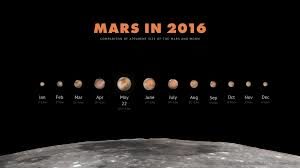Everything you ever wanted to know about Mars but were too afraid to ask – Ben Willis
Mars is the fourth planet from the sun in our solar system and is a harsh, cold and rocky wilderness, which has never been explored by humans. It is the second closest planet to Earth, getting as near as 34 million miles, still 10 million miles further than Venus’s closest pass. To put that into perspective, the distance is at least 1360 times the circumference of the Earth. While the planets in the solar system are in the same plane, due to the spin of the sun, they still have constantly changing distances from one another because they all have different lengths of year (how long it takes the planet to orbit the Sun). This can be affected by two things, the speed of the planet and the distance from the sun (the radius of the orbit).

We measure all of this based on Earth days. Mars has a 687 day orbit, so a 687 day year, which is almost double that of the Earth. At its furthest point Mars can be 250 million miles away, therefore the timing of any mission is crucial. There is only a relatively short window every two years when the planets are at their closest. Even at this distance (33.9 million miles) it is still 147 times further than any human has ever travelled into space, the furthest being the moon at 238,855 miles.
WHY MARS?
Mars is fascinating because there used to be water on the planet and as a result of this there are many geographical features similar to ones we find here on Earth. There are aquifers that could hold liquid methane or water which could be used as fuel and converted into oxygen. There is definitely water on the planet in the form of water ice on the poles. We can see canyons from Earth and from photos taken during previous missions that indicate tectonic movement and the presence of water. One such canyon is Valles Marineris; the huge seam in the smooth surface can be seen in the picture a bit further down. Thanks to rifts like this, we know that Mars once had a molten core and could have had a magnetic field that would have been able to stop the harsh radiation from the sun and retain an atmosphere. This core is now thought to have solidified, and is comprised predominantly of iron, nickel and sulphur. As a result of this, there is less heat being radiated from the core, so the mantle is dormant and there is no tectonic movement. The surface of Mars is mainly basaltic rock, formed when volcanoes erupt and cool quickly. This would have happened due to the extremely cold temperatures on Mars, which can be as low as -133°C at the poles in winter. The largest volcano on Mars is called Olympus Mons and is also the largest peak in the solar system, towering over the landscape at 16 miles high. If you were on the side of this awesome volcano, you probably wouldn’t notice the gradient as it is 374 miles in diameter. The typical red colour on Mars comes from the fine dust of oxidised iron (rust) that covers the surface, making it very harsh and desert-like, not dissimilar to some of the most extreme conditions on Earth, but significantly colder. Finally, the atmosphere is comprised mainly of CO₂ (95%) which means that if the issues of temperature and fertile soil were resolved, then there would be plenty of CO₂ for plants to thrive. We could also separate any discovered water (in the form of ice) to extract oxygen that the astronauts will need to breathe.

The atmosphere on Mars is very thin due to its depleted magnetic field and relatively small mass. Mars is also the most likely planet in our solar system to be able to host life, making it the one we are most interested in exploring. There have been a plethora of ideas about life on Mars, from scientists searching for bacteria, to people believing that there may be aliens living there! When the first spacecraft sent back pictures of Mars in 1964 (Mariner 4), people didn’t know what to expect and were somewhat underwhelmed by the barren landscape that faced them on their screens. Because of this, activity involving missions to Mars slowed down for a little while until Mariner 6 and Mariner 7 in 1969 which both did flybys and re-ignited interest with 201 pictures being sent back to Earth between them. The gravity on Mars is 38% of that on Earth, about 3.7m/s² and roughly twice the gravity on the moon. Along with frozen CO₂ on Mars, there is also water-ice (H₂O(s)) which could be utilised for the production of oxygen to breathe and rocket fuel to get back to Earth. This fuel can be made using the anthraquinone process giving hydrogen peroxide (H₂O₂) as a product of the reaction. This process is complex but I would recommend researching it if you are interested, more information can be found here: http://nzic.org.nz/ChemProcesses/production/1E.pdf. The Martian day (the time taken for a planet to spin 360° around its axes) is only 40 minutes longer than one on Earth, meaning a working day would be similar.
GETTING THERE
The journey to Mars will not be a simple straight line, because if we aim for Mars, it may have travelled half of its orbit before we reach where it was and the astronauts would be hurtling off into deep space with no way to stop. What NASA has done in the past is that they have launched a space craft into Mars orbit in a curved shape, and then intercepted with Mars in its orbit to land. This means that the distance travelled will be a lot further and the margin for error is even smaller, a millimetre out leaving Earth orbit could mean 10 miles out when getting to Mars and this would be a disaster. As for the rocket that will take them there, Orion is looking the most likely. It reached speeds of 20,000 mph in the tests that took place in December 2014 when everything went well. The other possible option is the fusion rocket, which uses nuclear fusion (the reaction that gives out heat and light from the Sun) to generate thrust, expelling rings of lithium and generating speeds of up to 200,000mph. The problem with this is that it is a very delicate reaction and would require the reaction to generate more power than is put in initially. This is the issue with any kind of nuclear fusion that is being tested, along with the fact that the reactions often do not last very long. The other challenge with having a 200,000 mph rocket for a journey to Mars is stopping it. The likelihood is that it will simply deflect off the side, not enter orbit and be bounced into deep space with no hope of return. There have been 43 previous unmanned missions to Mars, some with the intention of a flyby, and some that landed. Of the 43 that were launched, only 19 were successful. This is not a good enough success rate at the moment, as when we send manned missions to Mars, we will want to ensure the safety of all those involved.
LIVING ON MARS
As the length of the day is very similar to that on Earth, after the journey it may be a relief for the astronauts to get back to something like a normal routine. Although there has been a lot of talk about “The 100” (the people who will gain themselves a one way trip to Mars and colonise it), NASA along with ESA and Russia are planning to launch a series of missions to the planet before this happens. The first ones are projected to be in the early 2030s, however things can change and it may still be postponed for a few more years. The last thing they want is for something to go wrong.
On the physical side of being on Mars, the astronauts of any mission will need to be protected from the following things: Radiation from the Sun due to the lack of magnetic field; the freezing temperatures with an average of -60°C; the pressure which is about 0.6% of that on Earth at sea level and dust storms with winds of up to 60 mph, where it can take months for the dust to settle. To protect the astronauts from all of these things without them having to wear a bulky suit, there are plans for some kind of shelter or habitat. In terms of strength, a geodesic structure is the best, a series of triangles creating a dome – similar to the Eden Project. This will then be pressurised and given an atmosphere for the astronauts to breathe. The problem with all of this is that some materials like glass do not lend themselves to being launched in a rocket at speeds of 20,000 mph. For this reason, many materials are being tested at this very moment in the USA at JPL (Jet Propulsion Lab) and at NASA by materials engineers to ensure that the best possible structure is devised. The astronauts will also need some form of suit to wear when outside this home area. In the past and at present, the suits used by astronauts are not skin-tight, and a pressure is kept outside the skin, so that the astronaut is effectively in a pocket of pressurised oxygen. As a result of this, the suits are cumbersome, and every time an astronaut closes their hand, it is like squeezing a tennis ball even if nothing is being gripped. These suits are far from perfect for the meticulous and precise research work that will be done on Mars.
To resolve this there have been multiple designs for skin-suits or bio-suits, like the one shown in the picture, that allow the pressure to be applied directly to the skin rather than having a pocket of air. The oxygen tanks that will be used are also a lot more compact and the whole outfit is designed for comfort and ease of movement. This will mean no more unwieldy suits and will help the astronauts to carry out their daily tasks with ease. Most of these designs include a screen-type display on the inside of the helmet, giving the astronaut their vital signs as well as any other information they need to know. Microphones may also be a good idea for communication among the team. Communication back to Earth will not be instantaneous as it takes light at least 3 minutes to travel from Earth to Mars and possibly up to 20. Therefore there will be a delay of between 6 and 40 minutes, with a black spot when Mars is around the other side of the Sun. For the activities that will inevitably have to be further than just outside the door, it will be more efficient as well as a lot easier to use some form of rover to undertake these journeys. Many such products have been designed, such as one that enables the astronauts to get into their suit, which is kept on the outside of the rover, by accessing it through the rover. They will also travel in pairs so that if one rover breaks down, all of the people can still fit in the other and drive back to base. The speed that it is likely to travel is about 6mph, which is a lot better than by foot, and the energy will be generated by solar power, because the sunlight will be strong. Even though it is further away, the diminished atmosphere means that more light and heat will get to the planet easily.
In the summer sun on the equator of Mars it can reach temperatures of 20°C, a British summer’s day. For this reason, all of the materials and equipment used must be able to withstand a large range of temperatures as well as severe and sudden temperature changes, just like the equipment used on the ISS (International Space Station). The home or habitat area will also have to be strong enough to survive severe dust storms, as sometimes these can cover half of the planet. This will mean that they have to be light for the journey, but then as strong as a proper building when it gets there as well as being pressurised and have oxygenated air inside. The oxygen level is hopefully going to be boosted by growing plants for food for the people. A similar thing was attempted to see how a colony of people separated from the rest of the world would survive in Biosphere 2. In this experiment, they found that after only a month or so, the people were not at their best, were not operating together and had no motivation. It was later found that this was due to the concrete walls that had not fully set, so absorbed more oxygen than they had anticipated. This just shows us how vital the perfect level of oxygen is, otherwise things could end up with the people falling out and not cooperating as they should. This would be a serious risk for the safety of everybody.
SUMMARY
In my opinion, Mars is truly an extraordinary planet and is definitely the next step in space travel which will determine whether we can travel to other possible planets hosting life. We are truly treading into the unknown, and we need to do this to advance as a race. Most of the information in this article is only there thanks to the missions that have already occurred. Think about the groundbreaking discoveries and scientific advancements we may make. Without missions into space, we can never find out whether there is other life out there in the universe, and we cannot attempt to save our species from our inevitable fate. Mars is the next giant leap, and I very much look forward to the discoveries that will be made and hope that they will help us to advance in the world of science and space exploration.
SOURCES
http://nzic.org.nz/ChemProcesses/production/1E.pdf















Post Comment
You must be logged in to post a comment.